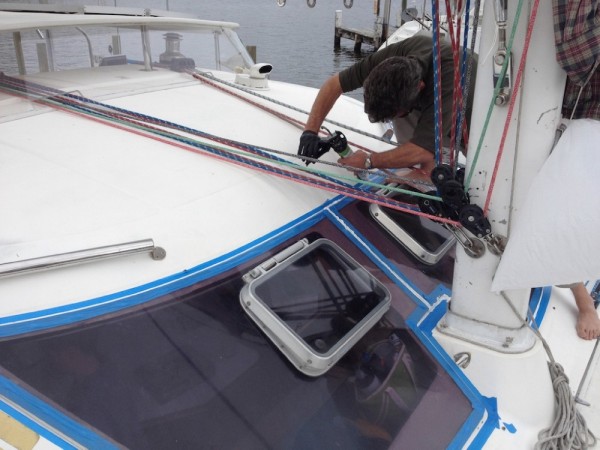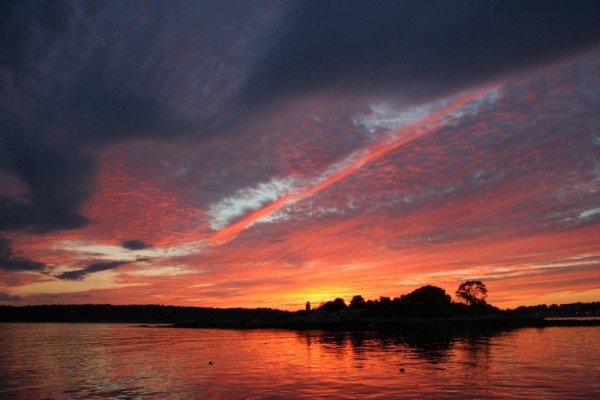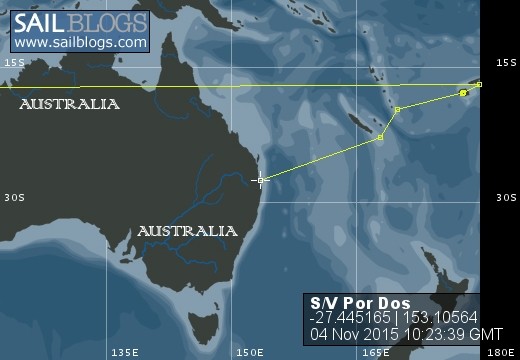
Por Dos
Family cruising in a Catamaran
16 December 2017 | Brisbane
04 November 2015 | Brisbane, Australia
30 October 2015 | Isle de Pines, Noumea, New Caledonia
08 October 2015 | Tanna, Vanuatu
01 October 2015 | Viti Levu, Mololo, Fiji
21 September 2015 | Namena, Musket Cove Malolo, Vuda Point Viti Levu, Fiji
12 September 2015 | Vanua Levu and Taveuni, Fiji
02 September 2015 | Tonga
13 August 2015 | Suwarrow, Cook Islands
25 July 2015 | Tahaa, Bora Bora and Maupiti French Polynesia
17 June 2015 | Tahiti & Moorea, French Polynesia
16 June 2015 | Fakarava, Tuamotu Islands, French Polynesia
06 June 2015 | Tahanea, Tuamotu Islands, French Polynesia
01 June 2015 | Raiatea, Tuamotu Islands, French Polynesia
28 May 2015 | Taiohae Bay, Nuku Hiva, Marquesas Islands, French Polynesia
12 May 2015 | Taiohae Bay, Nuku Hiva, Marquesas Islands, French Polynesia
26 April 2015 | Academy Bay, Puerto Ayora, Santa Cruz, Islas Galapagos, Ecuador
13 April 2015 | Panama to Galapagos
07 April 2015 | Balboa, Panama
31 March 2015 | Colon, Panama
Pacific: Obviously a Misnomer
12 May 2015 | Taiohae Bay, Nuku Hiva, Marquesas Islands, French Polynesia
Marta Portoles
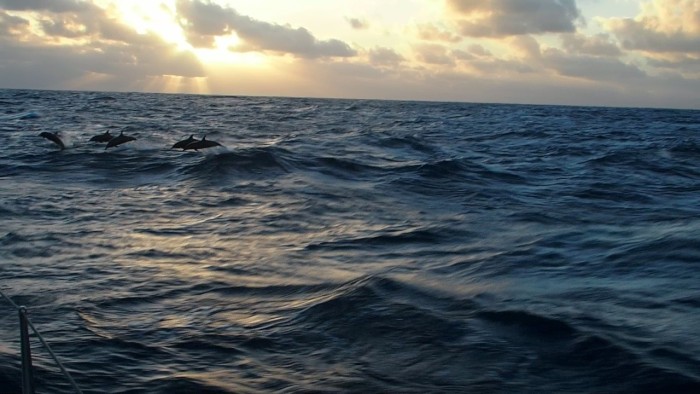
We left Galapagos with a nice breeze filling our full mainsail and jib. Right from the start we had a fast passage with many days of sailing over 200 miles (until our Code 0 sail went on the water, but more on that later), sadly however, it was not a smooth one. The seas were often confused with waves coming from different directions. We never quite found the forecasted westerly heading current that would have added one to one and two knots to our speed. More often than not, we found areas of counter currents subtracting half a knot or even a knot to our speed and adding choppiness to the already uncomfortable seas. Despite all of that, we manage to surpass our previous record of 211 nm in 24 hours: we did 222 nm one day and 218 nm the next, with other days at 209 and 210 nm, and several more at or around 200 nm for a total of 16 days crossing from Galapagos to Marquesas.
We maintained the watches that worked well for our family in previous crossings and the activities that had kept us entertained in the past – mostly reading, playing cards with some movie watching on the days that we had to run the engine to charge the batteries. Yes! Even with our 10 solar panels, with the sails on the starboard side shading the afternoon sun from the panels, and the continuous running of navigation gear (specially autopilot), we had to run the engines for a couple of hours every 48 hours.
We had few issues to deal with: the first one happened almost immediately after starting the trip, when we realized that the instruments wind vane at the top of the mast was missing, so we could collect apparent wind speed but not direction and not true wind speed. How the wind vane broke is anyone's guess but we remembered several pelicans and other large birds attempting to perch on the top of our mast while in Galapagos. We had a spare but it was not worth the dangerous exercise of sending Mark up the mast in the confused non-pacific seas of the Pacific Ocean. We had to read the wind true force and direction like the real sailors of the past by looking at the water and feeling it in our faces :).
Our second issue was a broken pin on the shackle that holds the main tack to the boom. After trying to fix it in a couple of different ways, we ended up replacing it for a Dyneema soft shackle, adding a second soft shackle as a back up. [Three months later, this soft shackle system is working very well].
Ten days into our passage and with 1000 nm to go, the sewn eye on the torsion rope of the Code 0 became unstitched and let go: translation, the Code 0 ended up in the water. Luckily this time it happened in the afternoon, with plenty of light for the four of us to pull the sail wet but undamaged into the trampoline. We rolled the sail into its bag, unfurled the jib and continued sailing albeit at a slower pace. Not that I wanted any expertise on rescuing sails from the seas, but we have become real pros and went through the whole exercise in less than an hour. Sailing with the jib alone, our 200 mile days came to an end; we were doing 180 to 170 miles days so our 15-day passage became a 16-day one.
About 500 miles from Marquesas, the autopilot started to wander a bit more than usual. Nothing was obviously wrong when Mark investigated, so he adjusted the autopilot settings to make it more responsive, which seemed to fix the issue [more on this on a later blog].
In terms of fauna, we saw one high-dome turtle swimming in the surface on day 7 of our passage. The dolphins that we have seen close to Galapagos had not been interested in Por Dos, but as we were getting closer to Marquesas, we had many hundreds of Common dolphins visiting – at some point the water was full of dolphins as far as we could see. There were babies and mothers, really small and big ones; some will jump up high, others were just focused on getting to Por Dos bows. We enjoyed watching them for hours.
Early on the trip, a flying fish attacked Roan. This is not unusual per se; many a sailor has been hit by flying fish while at the helm or in the cockpit. However, Roan happened to be inside the companionway. It was 8 PM, and he was talking with Alec and me in the galley, while Mark was at the helm. A flying fish flew all the way from the stern of the boat, across the cockpit, and into the saloon. It hit Roan on his upper arm and fell down on the galley floor. Initially Roan thought that Mark had thrown something at him, but he soon spotted the poor fish flapping desperately around. Roan grabbed him with a paper towel and through it back to sea. The fish, was probably as surprised, and more afraid than Roan.
Tuesday, May 12, we sailed into Taiohae Bay in Nuku Hiva, after a 16-day passage across the South Pacific waters. Our most lonely crossing, we had only spotted by sight three or four fishing boats in the first 200 miles from Galapagos and by AIS a small cargo ship 30 nm from us on its way to Japan when we were 500 miles from our destination. We were happy to make land; it had been an uncomfortable, rocky passage, but nothing that a solid night sleep would quickly wipe from our memories (until written in this blog of course).
We maintained the watches that worked well for our family in previous crossings and the activities that had kept us entertained in the past – mostly reading, playing cards with some movie watching on the days that we had to run the engine to charge the batteries. Yes! Even with our 10 solar panels, with the sails on the starboard side shading the afternoon sun from the panels, and the continuous running of navigation gear (specially autopilot), we had to run the engines for a couple of hours every 48 hours.
We had few issues to deal with: the first one happened almost immediately after starting the trip, when we realized that the instruments wind vane at the top of the mast was missing, so we could collect apparent wind speed but not direction and not true wind speed. How the wind vane broke is anyone's guess but we remembered several pelicans and other large birds attempting to perch on the top of our mast while in Galapagos. We had a spare but it was not worth the dangerous exercise of sending Mark up the mast in the confused non-pacific seas of the Pacific Ocean. We had to read the wind true force and direction like the real sailors of the past by looking at the water and feeling it in our faces :).
Our second issue was a broken pin on the shackle that holds the main tack to the boom. After trying to fix it in a couple of different ways, we ended up replacing it for a Dyneema soft shackle, adding a second soft shackle as a back up. [Three months later, this soft shackle system is working very well].
Ten days into our passage and with 1000 nm to go, the sewn eye on the torsion rope of the Code 0 became unstitched and let go: translation, the Code 0 ended up in the water. Luckily this time it happened in the afternoon, with plenty of light for the four of us to pull the sail wet but undamaged into the trampoline. We rolled the sail into its bag, unfurled the jib and continued sailing albeit at a slower pace. Not that I wanted any expertise on rescuing sails from the seas, but we have become real pros and went through the whole exercise in less than an hour. Sailing with the jib alone, our 200 mile days came to an end; we were doing 180 to 170 miles days so our 15-day passage became a 16-day one.
About 500 miles from Marquesas, the autopilot started to wander a bit more than usual. Nothing was obviously wrong when Mark investigated, so he adjusted the autopilot settings to make it more responsive, which seemed to fix the issue [more on this on a later blog].
In terms of fauna, we saw one high-dome turtle swimming in the surface on day 7 of our passage. The dolphins that we have seen close to Galapagos had not been interested in Por Dos, but as we were getting closer to Marquesas, we had many hundreds of Common dolphins visiting – at some point the water was full of dolphins as far as we could see. There were babies and mothers, really small and big ones; some will jump up high, others were just focused on getting to Por Dos bows. We enjoyed watching them for hours.
Early on the trip, a flying fish attacked Roan. This is not unusual per se; many a sailor has been hit by flying fish while at the helm or in the cockpit. However, Roan happened to be inside the companionway. It was 8 PM, and he was talking with Alec and me in the galley, while Mark was at the helm. A flying fish flew all the way from the stern of the boat, across the cockpit, and into the saloon. It hit Roan on his upper arm and fell down on the galley floor. Initially Roan thought that Mark had thrown something at him, but he soon spotted the poor fish flapping desperately around. Roan grabbed him with a paper towel and through it back to sea. The fish, was probably as surprised, and more afraid than Roan.
Tuesday, May 12, we sailed into Taiohae Bay in Nuku Hiva, after a 16-day passage across the South Pacific waters. Our most lonely crossing, we had only spotted by sight three or four fishing boats in the first 200 miles from Galapagos and by AIS a small cargo ship 30 nm from us on its way to Japan when we were 500 miles from our destination. We were happy to make land; it had been an uncomfortable, rocky passage, but nothing that a solid night sleep would quickly wipe from our memories (until written in this blog of course).
Comments
| Vessel Name: | S/V Por Dos |
| Vessel Make/Model: | Catana 48 |
| Hailing Port: | Salem, MA |
| Crew: | Mark, Marta, Alec & Roan |
Us
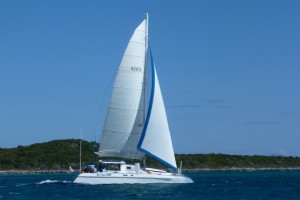
Who: Mark, Marta, Alec & Roan
Port: Salem, MA
